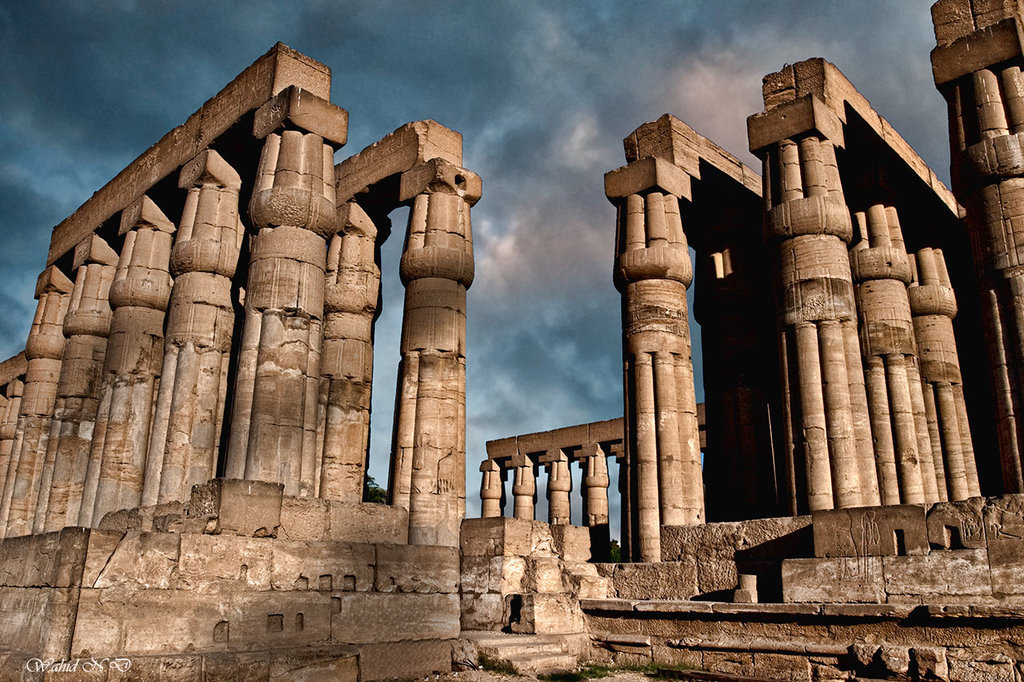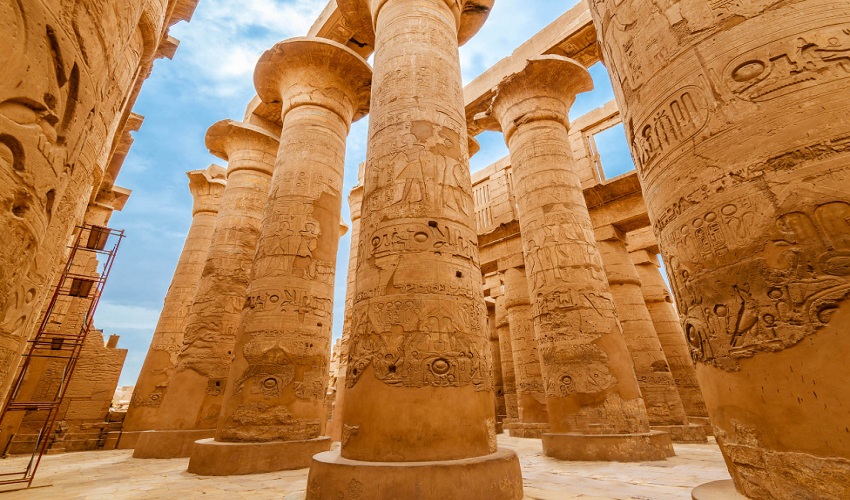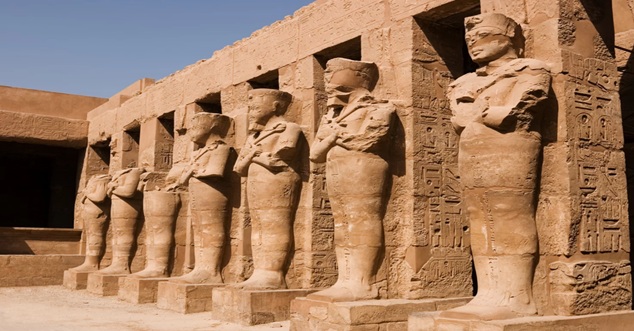Karnak Temple | Karnak Temple Complex Luxor Egypt
Rising proudly on the east bank of the Nile, the Karnak Temple Complex is one of the most magnificent architectural achievements in human history. Often described as the largest open-air museum in the world, Karnak is more than just a temple — it’s a living chronicle of ancient Egypt’s spiritual and political evolution.
Stretching across over 200 acres, Karnak is a massive collection of temples, chapels, pylons, and obelisks built and expanded by more than 30 pharaohs over 2,000 years. Dedicated primarily to the Theban Triad — the gods Amun, Mut, and Khonsu — Karnak served as the beating heart of ancient Thebes and the spiritual center of the Egyptian empire.
Visiting Karnak Temple is like stepping into a vast time machine. Every stone, relief, and hieroglyph bears witness to a civilization that sought eternity through its art, religion, and architecture.
A Monument to the Gods
Karnak’s name in ancient Egyptian was Ipet-Isut, meaning “The Most Perfect of Places.” It was here that Amun-Ra, king of the gods, was worshiped in grandeur unmatched anywhere else in the ancient world.
The temple complex grew organically over centuries, as each ruler added chapels, courts, and sanctuaries to honor the gods and assert their divine right to rule. The scale of construction was staggering — at its height, Karnak employed thousands of artisans, priests, and laborers, all devoted to the service of Amun.
Unlike a single structure, the Karnak Temple Complex is an interconnected maze of sacred spaces. The most famous and largest section is the Precinct of Amun-Ra, but other areas, such as the Precinct of Mut and the Precinct of Montu, played equally important roles in Theban religious life.
A History Carved in Stone
The story of Karnak begins during Egypt’s Middle Kingdom (around 2000 BCE) but reached its zenith in the New Kingdom (1550–1070 BCE). Almost every major pharaoh of this era contributed to the complex, expanding and embellishing it to glorify the gods — and themselves.
-
Senusret I (12th Dynasty) built one of the earliest shrines to Amun.
-
Hatshepsut constructed the Red Chapel and obelisks that still tower over the site.
-
Thutmose III, Egypt’s great warrior-king, built pylons, halls, and courts, turning Karnak into a royal archive of victory.
-
Amenhotep III, Seti I, and Ramses II added statues, temples, and monumental gateways.
Even later rulers — the Ptolemies and Romans — left their marks, ensuring Karnak remained a living temple long after Egypt’s golden age had faded.
Each addition reflected the politics, theology, and artistry of its era, creating a layered architectural palimpsest unmatched anywhere in the ancient world.

The Great Hypostyle Hall: Egypt’s Stone Forest
The heart of Karnak — and one of the most awe-inspiring spaces ever built — is the Great Hypostyle Hall. Covering an area of over 50,000 square feet, this hall was constructed by Seti I and completed by his son Ramses II around 1290 BCE.
It contains 134 colossal sandstone columns, arranged in 16 rows. The central 12 columns rise to an astonishing 21 meters (69 feet), each crowned with papyrus-shaped capitals that seem to blossom toward the heavens.
Walking through this forest of stone is an almost spiritual experience. Sunlight filters through the roof gaps, casting moving shadows across hieroglyphs that still glow with traces of their original paint.
The walls and columns are covered with reliefs showing Pharaohs making offerings to Amun, triumphing in battle, and receiving blessings from the gods. Each image is a prayer, carved in eternal stone.
The Sacred Lake and the Daily Rituals
To the south of the main temple lies the Sacred Lake, a vast artificial pool once used for religious purification ceremonies. Priests would bathe here before performing sacred rites inside the temple, while barques carrying statues of gods were ritually purified in its waters.
In ancient times, the lake reflected the temple’s towering pylons and obelisks — a perfect symbol of the divine order mirrored in nature. Even today, the stillness of the lake offers visitors a moment of calm amid the grandeur of Karnak.
The Obelisks of Karnak
Among Karnak’s most striking features are its towering obelisks — monolithic pillars of granite carved from a single piece of stone. Each was erected to honor the sun god Ra, symbolizing a ray of sunlight frozen in stone.
The most famous of these belonged to Queen Hatshepsut, who erected two colossal obelisks of red granite from Aswan, each weighing more than 300 tons. One still stands proudly, soaring above the ruins, bearing inscriptions that proclaim her divine lineage and devotion to Amun.
Nearby, the obelisk of Thutmose I, her father, remains another enduring landmark — a link between two of Egypt’s most remarkable rulers.

The Avenue of Sphinxes: Gateway of the Gods
Stretching nearly three kilometers between Karnak Temple and Luxor Temple lies the majestic Avenue of Sphinxes, known in ancient times as the Sacred Way.
Lined with hundreds of ram-headed sphinx statues — symbols of Amun’s power — this ceremonial avenue was the path of the Opet Festival, one of ancient Egypt’s grandest religious events.
During this annual celebration, statues of the Theban Triad were carried on sacred boats from Karnak to Luxor amid music, incense, and chanting. The festival symbolized the renewal of kingship and the harmony between gods and humans.
In recent years, Egypt has restored this ancient route, allowing modern visitors to walk the same path once reserved for the divine.
The Temples Within Karnak
While the Precinct of Amun-Ra is the centerpiece of Karnak, the complex includes several other important temples and chapels:
1. The Precinct of Mut
Dedicated to the goddess Mut, wife of Amun, this area once featured a sacred lake shaped like a crescent and was home to numerous statues, including many of Sekhmet, the lion-headed goddess of war.
2. The Precinct of Montu
Montu, the falcon-headed god of war, was honored in his own precinct north of the main complex. This smaller but significant area reflects the martial spirit of Thebes.
3. The Temple of Khonsu
Built by Ramses III, the Temple of Khonsu (the moon god) stands near the southern entrance. It is one of the best-preserved examples of New Kingdom temple architecture, with impressive pylons and sanctuaries.
4. The Open-Air Museum
Located within Karnak itself, this section houses reconstructed chapels such as the White Chapel of Senusret I and the Red Chapel of Hatshepsut — masterpieces of ancient art rescued from centuries of reuse and decay.
Art, Symbolism, and Religion
Every relief and hieroglyph at Karnak carries layers of meaning. The walls were not merely decorative — they were theological texts, visual prayers expressing Egypt’s worldview.
Scenes depict:
-
The pharaoh presenting offerings to Amun-Ra.
-
The gods bestowing symbols of life (ankh) and power (was scepter) upon the king.
-
Triumphs in battle framed as divine victories.
These images affirmed the pharaoh’s dual role — as both mortal ruler and divine intermediary. The temple thus functioned as both cosmic diagram and political statement, linking heaven and earth, god and man.
.jpg)
Engineering and Construction
Karnak’s construction spanned centuries, with materials transported from distant quarries — granite from Aswan, sandstone from Gebel el-Silsila, and alabaster from Hatnub.
Massive blocks were hauled using wooden sledges and lubricated paths of water and mud. The precision with which the columns align and the pylons rise still astonishes modern engineers.
Inscriptions reveal that thousands of skilled workers, artists, and priests lived in nearby settlements, forming a vibrant temple economy that sustained the region.
The Opet Festival: Celebration of Renewal
The Opet Festival was Karnak’s most important annual event. It celebrated the divine marriage between Amun and Mut and the rejuvenation of the pharaoh’s rule.
During the festival, statues of the Theban Triad were carried from Karnak to Luxor Temple in elaborately decorated boats, accompanied by priests, musicians, and citizens. Offerings, dancing, and prayers filled the streets of Thebes in a joyous expression of unity between the gods and the people.
Today, visitors can still imagine this grand procession as they walk the restored Avenue of Sphinxes, connecting the two great temples.
Modern Discoveries and Restoration
Archaeological work at Karnak continues to this day, led by the Centre Franco-Égyptien d’Étude des Temples de Karnak (CFEETK).
Ongoing projects include:
-
Cleaning and restoring reliefs to reveal their original colors.
-
Mapping hidden structures beneath the ground.
-
Reconstructing chapels and shrines within the Open-Air Museum.
Each discovery adds new layers to our understanding of ancient Egyptian religion, politics, and daily life.
.jpg)
Visiting Karnak Temple: A Traveler’s Guide
???? Location
East Bank of the Nile, Luxor, Upper Egypt
???? Opening Hours
Daily: 6:00 AM – 5:00 PM
???? Entrance Fees (2025)
-
General Ticket: 450 EGP
-
Student Ticket: 230 EGP
???? Getting There
Karnak is about 3 km north of Luxor Temple. Visitors can take taxis, horse-drawn carriages, or guided tours that include both sites.
???? Travel Tips
-
Visit early morning or sunset for cooler temperatures and softer light.
-
Hire a licensed guide to fully appreciate the site’s history.
-
Bring water, sunscreen, and comfortable walking shoes.
-
Attend the Karnak Sound and Light Show in the evening for a magical storytelling experience.
Nearby Attractions
-
Luxor Temple – connected to Karnak by the Avenue of Sphinxes.
-
Luxor Museum – showcasing statues and artifacts discovered in Thebes.
-
Valley of the Kings – final resting place of Egypt’s most powerful pharaohs.
-
Temple of Hatshepsut – the stunning mortuary temple of Egypt’s great queen.
-
Colossi of Memnon – two massive seated statues guarding the Theban necropolis.
The Sound and Light Show
One of the most captivating ways to experience Karnak is through its Sound and Light Show, held every evening. Narrated with dramatic lighting and music, the show guides visitors through the temple’s pylons and courtyards while recounting the story of Thebes, its pharaohs, and its gods.
As the voices of Amun and Ramses echo through the ruins, the ancient stones seem to awaken, reminding every visitor that Karnak is not a relic — it is a living monument.
Spiritual Experience and Legacy
Karnak’s immense power lies not only in its architecture but in its spiritual resonance. Even thousands of years later, the site retains a palpable sense of sanctity.
For the ancient Egyptians, Karnak was a bridge between heaven and earth. For modern travelers, it is a place of wonder and humility — a reminder of humanity’s eternal quest for the divine.
Every column, every inscription, whispers the same message: that the pursuit of harmony between gods, nature, and man is timeless.
Conclusion
The Karnak Temple Complex is more than an archaeological site — it is the beating heart of ancient Egypt, the spiritual axis of Thebes, and one of humanity’s greatest achievements.
To stand beneath its towering columns and gaze upon its hieroglyphs is to commune directly with history. Here, pharaohs prayed, priests sang, and civilizations rose and fell — yet Karnak endures, eternal as the gods it honors.
Whether you are a historian, a spiritual seeker, or a curious traveler, Karnak Temple offers a journey unlike any other — a walk through the very soul of Egypt.
Step into the grandeur of Karnak Temple — explore its sacred halls, witness the legacy of the pharaohs, and let Egypt’s timeless spirit inspire your journey!


